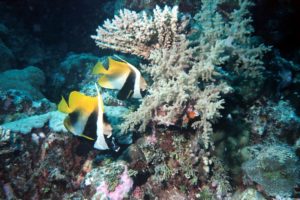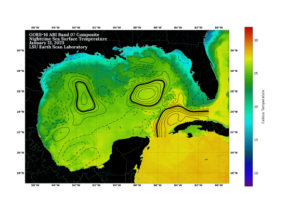Dr. Frank Muller-Karger, University of South Florida, satellite products.
“Advancing Products to Support Marine Life Studies and Management Assessments”
GCOOS and the IOOS programs are working with the Marine Biodiversity Observation Network (MBON) to integrate biological data into ocean observing. This  work is part of the Healthy Ecosystems and Living Resources Key Focus Area of the GCOOS Strategic Plan (2020-2025).
work is part of the Healthy Ecosystems and Living Resources Key Focus Area of the GCOOS Strategic Plan (2020-2025).
The goal of MBON is to support coastal and offshore studies of marine life, including addressing the needs for environmental and biological observations of the National Marine Sanctuaries (Flower Garden Banks National Marine Sanctuary, Florida Keys National Marine Sanctuary). The collaboration between GCOOS and MBON helps advance rapid, frequent, synoptic, and accessible maps of multiple Essential Ocean Variables (EOV), and links GCOOS with the efforts to develop Essential Biodiversity Variables.
Among the examples that we will discuss are efforts to validate biogeographic “Seascapes” developed by MBON researchers in collaboration with CoastWatch (NOAA NESDIS) and NASA, monitoring for coastal plumes impacts on the Flower Garden Banks, and characterizing phytoplankton species variability and changes in reef-fish biodiversity in waters of the Florida Keys.
GCOOS and MBON have pioneered the implementation of data management strategies to facilitate the dataflow of biological observations using standardized data formats (such as DarwinCore) into open regional and international databases such as the Ocean Biodiversity Information System (OBIS). These approaches are now adopted across IOOS Regional Associations. GCOOS and MBON welcome biologists and ecologists in the region to join and participate in this collaborative activity to characterize multistressor patterns (changes in phenology and biodiversity, temperature, salinity, acidification, pollution, etc.) and to evaluate resilience and vulnerability of ecological systems of the region.
Dr. Frank E. Müller-Karger is a Professor in the College of Marine Science, University of South Florida (USA). As a biological oceanographer, Dr. Müller-Karger’s research focuses on how marine ecosystems change over time. He evaluates links between water quality, primary production and biodiversity in coastal marine environments, and how these may be connected to climate change and human activities. Muller-Karger serves as the co-lead of the U.S. and international Marine Biodiversity Observation Network (MBON), the Marine Life 2030 program endorsed by the UN Decade of Ocean Science for Sustainable Development and the NOAA Climate Program Office/Sanctuaries Climate Indicator Task Force. He has published more than 340 peer-reviewed articles and is the 2021 recipient of the William T. Pecora Award (Individual); is a AAAS Fellow and served on the U.S. Commission on Ocean Policy.
Dr. Nan Walker, Louisiana State University Earth Scan Lab (ESL)
“LSU Earth Scan Lab (ESL) Satellite Image Products for GCOOS”
This talk will overview the satellite imagery that GCOOS is  funding ESL to produce daily, as well as applications for this imagery. A GOES SST animation will be shown to highlight the detachment of Warm Core Eddy Zodiac from the Loop Current around Christmas 2022. The record-breaking flood of the Mississippi River in 2019 will be discussed using a MODIS true color image animation. In addition, a short tour of the ESL website will be provided to facilitate accessing animations of hurricanes and hurricane cool wakes as well as the long-term (2-20 years) image archives, that document coastal and deep-water conditions and events in the Gulf of America.
funding ESL to produce daily, as well as applications for this imagery. A GOES SST animation will be shown to highlight the detachment of Warm Core Eddy Zodiac from the Loop Current around Christmas 2022. The record-breaking flood of the Mississippi River in 2019 will be discussed using a MODIS true color image animation. In addition, a short tour of the ESL website will be provided to facilitate accessing animations of hurricanes and hurricane cool wakes as well as the long-term (2-20 years) image archives, that document coastal and deep-water conditions and events in the Gulf of America.
Dr. Nan Walker has more than 30 years of experience in satellite remote sensing of coastal and oceanic processes. She has been employed as a faculty member at LSU in the Coastal Studies Institute and the Department of Oceanography and Coastal Sciences for more than 30 years, where she teaches graduate and undergraduate courses, advises M.S. and Ph.D. graduate students in their research, and has directed the ESL since 2003. She specializes in using satellite data to advance the understanding of physical processes and air-sea interactions, and has conducted research in the Gulf of America, Florida Keys/Bahama Bank region, the southern African region and the Caribbean Sea. Her research interests include Loop Current eddy circulation, air-sea interactions related to hurricanes and winter storms, estuarine-shelf exchange processes, surface sediment transport, coastal upwelling, and ocean climatology. She has experience in the application of visible, thermal, and microwave (SAR) satellite measurements. In recent years, she has focused on understanding Loop Current frontal eddy cyclone impacts on circulation and on ocean-atmosphere interactions that impact hurricane intensity changes. She has a B.S. in Marine Zoology (Duke University), an M.S. in Marine Sciences (Louisiana State University), and a Ph.D. in Physical Oceanography (University of Cape Town, South Africa). She spent a 2-year “sabbatical” with her husband starting in 1989 (after her Ph.D.), sailing their 32-foot sailboat from Cape Town to the Gulf of America, with a 6-month research experience in the West Indies Marine Lab, U.S. Virgin Islands, studying Hurricane Hugo’s impacts on the corals of St Croix. Her hobbies include scuba diving, photography, hiking, bicycling, and gardening.
